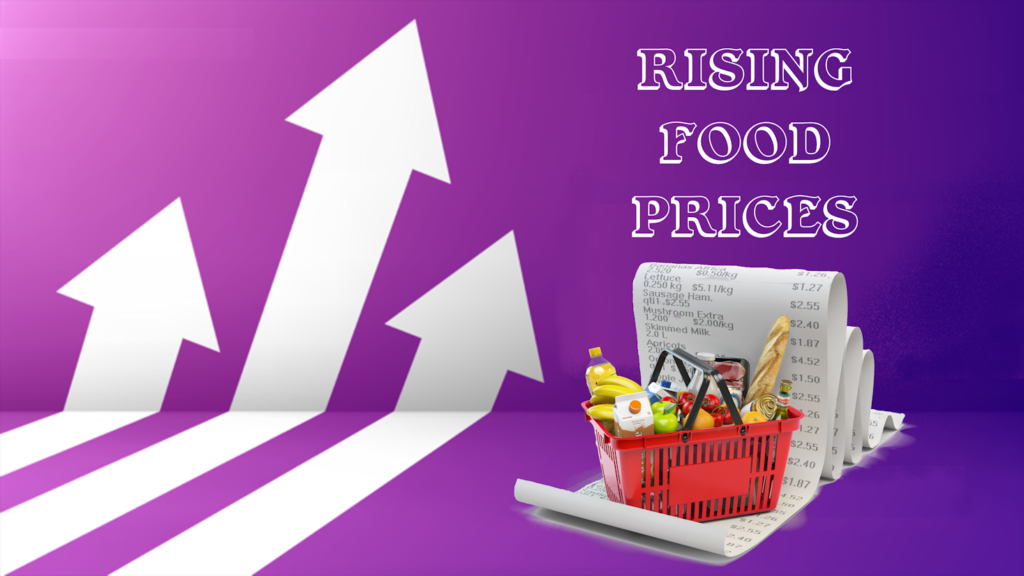Food prices are rising rapidly and consumers are feeling the pinch. CNN correspondent Gabe Cohen (@GabeCohenNews) reports, “Grocery costs keep climbing. Prices of meat, seafood, produce, cereal and other kitchen staples shot up 9% in 2021.”[1] Back in January, he noted that the primary causes of inflation were supply chain snarls, labor shortages, and Covid-19. Today, you can add the Ukraine war to that list. There are reports that inflation is changing everything from the products consumers buy to amount of food they eat.
Journalists Ximena Bustillo (@Ximena_Bustillo) and Steven Overly (@StevenOverly) attempt to explain “what’s driving the nation’s largest increase in food prices in 40 years” by deconstructing the all-American cheeseburger.[2] They discuss, in great detail, why each constituent part of the cheeseburger costs more. Here are the essentials (increases shown are from 2021 to 2022):

• Bun: The price of bread went up 7.1 percent.
• Bacon: The price of bacon jumped 18.2 percent.
• Egg: The price of eggs jumped 8.5 percent in 2020 and jumped an additional 3.9 percent in 2021.
• Avocado: The price of avocados soared 39 percent.
• Tomatoes: The price of tomatoes ticked up 1.7 percent.
• Lettuce: The price of lettuce increased 12 percent.
• Mayonnaise: The price of mayonnaise rose nearly 15 percent.
• Cheese: The price of cheese climbed 3.1 percent.
• Beef: The price of beef rose 16 percent.
Bustillo and Overly note, “The cost of food has always been politically fraught. It is influenced by a range of factors that have long sparked debate, from land use and environmental regulations, to labor rights and immigration policy.” Below are a few of the ways rising food prices are affecting the way we live.
Changing Consumer Spending
Consumer reporter Sharon Terlep (@sharonterlep) observes that inflation is now affecting the essential products consumers rely on most. She writes, “Household staples are no longer immune to inflation. American consumers are starting to cut costs on mainstays from toothpaste to baby formula as inflation hits a swath of the economy that had thus far proven resistant to substantial price increases.”[3] She continues, “Consumers, hit by soaring costs for everything from gasoline to child care, are drawing a line, analysts and retailers say. Shoppers are buying staples in smaller quantities, switching to cheaper, store-name brands and more rigorously hunting for deals. The shift is especially pronounced among lower-income consumers who splurged on household products amid the heights of the pandemic, they say. Private-label brands, after two years in which they lost market share to brand names, have begun to lure back buyers.”
Journalist Chabeli Carrazana (@ChabeliH) insists that the burden of rising costs falls hardest on the shoulders of women. She explains, “When inflation hits the grocery store, it’s women who feel the blow. And it’s women who have less room to adjust. … In a regular year, single women spend as much as 30 percent more than single men on most grocery items — the same items that are among those with the highest inflation increase, according to [an] analysis of Bureau of Labor Statistics data. (BLS analyzes expenditures for single men and women only.) It’s still women who are more likely to walk the grocery aisles to pick up food for themselves or their families and more likely to spend more on meals at home, which overall are up 10 percent with inflation.”[4] And, Carrazana notes, “[If you are already buying the cheapest brands you can find,] you can’t absorb a price hike. That’s when people start cutting back and skipping meals.”
These changes in consumer habits are happening around the globe. Bloomberg reports, “In India, roadside restaurateurs are halving their palm oil use and moving into steamed snacks. Bakers in Ivory Coast want to cut the size of their standard baguette. Sandwiches from U.S. fast-food stalls are headed for fewer slices of bacon, pizzas for a more parsimonious sprinkle of pepperoni. With the world economy already shackled by Covid-related shortages and now reeling from Russia’s invasion of Ukraine, prices of such basics as bread, meat and cooking oils have jumped across the world, sending shock waves through the commodity markets and damaging the global food system.”[5] Around the world, fears of going hungry are growing. Bloomberg observes, “For the most vulnerable societies — think Yemen, which imports 90% of its food in the midst of a grinding conflict and depreciating currency — this poses a genuine risk of hunger. Elsewhere, it triggers worries about what economists call demand destruction, a phenomenon when goods get too pricey to purchase.”
Mitigating Rising Prices
As Carrazana notes, consumers already buying the cheapest brands of the products they need have few options besides cutting back and eating less. Below are few tips for dealing with rising food prices when you’re on a tight budget. Beth Moncel, who runs the blog BudgetBytes, insists, “You have to be really strategic and intentional. Planning is probably one of the best ways to save money on groceries.”[6] She suggests poring over grocery sales flyers before shopping, joining store loyalty programs, and planning meals around cheap, filling items like rice and beans as well as shelf-stable ingredients like frozen vegetables. Terlep reports that some consumers are turning to dollar stores to find essential products at lower prices.
Cohen reports that grocers aren’t turning a blind eye to rising prices. He writes, “Deals can be had, if you know where to look. For example, Florida-based supermarket chain Winn-Dixie announced it is lowering the cost of 150 popular items by roughly 18% to ease inflation’s burden on shoppers.” Anthony Hucker (@chiefbagger), CEO of Southeastern Grocers, Winn-Dixie’s parent company, told Cohen, “We work with our national brand partners in selecting those products that mean that much to the customer at this particular time. Secondly, we have our own brand of products that typically range between 20 and 30% less than the national brand. … And the third thing we do is actually absorb some of the costs ourselves.” Terlep adds, “Grocery-industry executives say consumers are becoming more sensitive to price. They are switching to store brands for some products and increasingly trading down to cheaper items such as ground beef instead of steak.”
Concluding Thoughts
Bloomberg reports that, thanks to continued rising prices, “social unrest may be looming” in some areas of the world. The specter of starvation also casts it long shadow over many areas that rely heavily on food imports. In the United States, things aren’t much better. Journalist Chris Casey (@iamchriscasey) reports, “The inflationary trend is not expected to end any time soon. In an emailed statement, Leslie Sarasin, president and CEO of the Food Industry Association, pointed to predictions from the USDA Economic Research Service that food-at-home prices are expected to increase between 3% and 4% in 2022. Demand will continue to drive price increases, with the average weekly household spending currently at $148, compared to a pre-pandemic average of $113 per week, Sarasin said.”[7] Grocers are caught between suppliers and consumers and most are doing what they can to deal fairly with both.
Footnotes
[1] Gabe Cohen, “Why grocery prices keep surging,” CNN, 31 January 2022.
[2] Ximena Bustillo and Steven Overly, “This cheeseburger explains your bigger grocery bill,” Politico, 13 April 2022.
[3] Sharon Terlep, “With Inflation Not Letting Up, Shoppers Cut Back on Staples,” The Wall Street Journal, 4 April 2022.
[4] Chabeli Carrazana, “Inflation is hurting women at the grocery store. Some are eating less in order to feed their families.” Fortune, 12 April 2022.
[5] Bloomberg, “Soaring Prices Are Changing the Way People Eat,” SupplyChainBrain, 8 April 2022.
[6] Cohen, op. cit.
[7] Chris Casey, “Food-at-home prices jump 10% as supply chain, Ukraine war pressures mount,” Food Dive, 14 April 2022.





